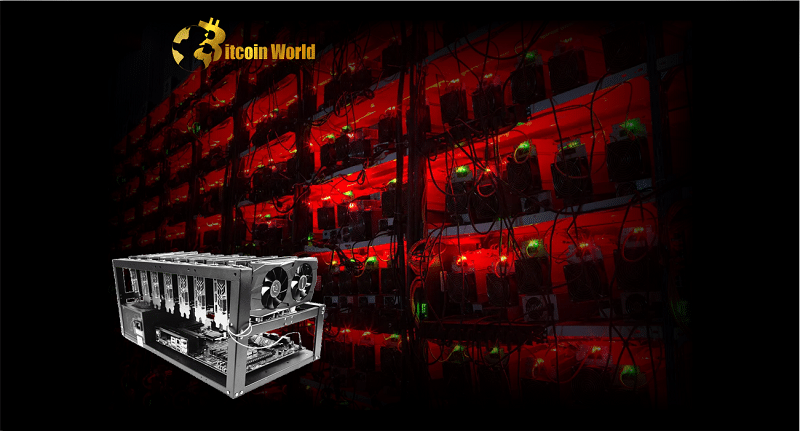Is Bitcoin mining finally shedding its reputation as an energy guzzler? Recent data suggests a significant shift towards sustainability. According to insights from Woo Charts and climate tech activist Daniel Batten, Bitcoin mining’s emissions intensity has reached its lowest point ever! This is big news for those concerned about the environmental impact of cryptocurrency. Let’s dive into what’s driving this positive change and what it means for the future of Bitcoin.
Bitcoin Mining Emissions: A Greener Trend?
Daniel Batten’s analysis, published on April 3rd, highlights a compelling trend: Bitcoin mining is becoming increasingly efficient in its emissions output relative to its energy consumption. This means that for every unit of energy Bitcoin mining uses, it now produces fewer emissions compared to the past. Take a look at this promising projection:
- Halving Emissions: Batten predicts that Bitcoin’s emissions per KWh will be cut in half within just three and a half years. This rapid pace of improvement is unmatched by other industries, signaling a serious commitment to environmental responsibility within the Bitcoin mining sector.
But what’s fueling this remarkable reduction in emissions intensity? Two key factors are at play:
The Power of Renewables: Bitcoin Mining’s Clean Energy Revolution
One of the most significant drivers is the increasing adoption of renewable energy sources by Bitcoin miners. Gone are the days when Bitcoin mining was solely reliant on fossil fuels. Today, a substantial portion of miners are turning to cleaner alternatives.
- Renewable Energy Dominance: A large majority of Bitcoin miners are now leveraging renewable energy sources to power their operations. This shift towards clean energy is dramatically reducing the carbon footprint of Bitcoin mining.
- Sustainable Hash Rate: The data indicates that a significant portion of the new hash rate – the computational power of the Bitcoin network – is being fueled by sustainable energy sources. This means that as the network grows, it’s increasingly powered by clean energy.
- Hydroelectric Hero: Hydroelectricity is emerging as a major energy source for Bitcoin mining, further solidifying the industry’s move away from fossil fuels.
Mining Equipment Efficiency: Tech Innovation for a Greener Bitcoin
Beyond renewable energy, technological advancements in mining equipment are also playing a crucial role in reducing emissions intensity.
- Efficient Machines: Modern Bitcoin mining equipment is significantly more energy-efficient than previous generations. This means miners can achieve the same computational output with less energy consumption, directly translating to lower emissions.
Bitcoin Mining Viability: Sustainability and Profitability Hand in Hand?
The report also touches upon the viability of Bitcoin mining, which, while slightly down from its peak, remains robust at around 54%. This high viability is directly linked to the increased use of sustainable energy. Essentially, miners are finding that clean energy isn’t just environmentally responsible; it’s also economically viable.
This paints a promising picture: Bitcoin mining can be both profitable and environmentally conscious, especially when powered by renewable energy sources.
The Bigger Picture: Bitcoin vs. Electric Vehicles
Interestingly, the report highlights that Bitcoin mining is now considered more environmentally friendly than even electric vehicle technology. This might come as a surprise to some, but it underscores the rapid strides Bitcoin mining is making towards sustainability.
However, it’s important to note that while emissions intensity is decreasing, overall emissions have seen a slight increase in the past couple of weeks. This is attributed to increased hash rate driven by methane flaring, despite efforts to use cleaner energy. This highlights that there is still work to be done, and continuous improvement is key.
Lawmakers and the Future of Bitcoin Mining
Despite these positive developments, lawmakers haven’t always recognized the progress made in Bitcoin mining’s energy efficiency.
- Policy Lag: Lawmakers are urged to acknowledge the significant improvements in energy efficiency within the Bitcoin mining sector and adjust policies accordingly.
- Texas Stance: Even in Texas, a major Bitcoin mining hub, there has been resistance to mining businesses, despite some legislative efforts to recognize the potential of BTC mining in the state.
It’s crucial for policymakers to stay informed about the evolving landscape of Bitcoin mining and its increasing commitment to sustainability. Outdated perceptions could hinder innovation and progress in this sector.
Bitcoin Mining by the Numbers: Network Stats
Let’s take a quick look at some key network statistics to understand the scale of Bitcoin mining:
| Metric | Value |
| Estimated Annual Electricity Usage (BTC Network) | 140 TWh (Cambridge University estimate) |
| US Electricity Lost Annually (Transmission & Distribution) | 206 TWh |
| Average Network Hash Rate (EH/s) | 349 Exahashes per second (EH/s) |
| Record High Hash Rate (March 24) | 398 EH/s |
| Network Difficulty (All-Time High) | 46.8 T |
| Mining Profitability | $0.078 per day per TH/s |
Source: Woo Charts, Daniel Batten, Cambridge University, BitInfoCharts
These figures illustrate the immense computational power behind the Bitcoin network and provide context for its energy consumption. It’s also worth noting that the electricity lost in transmission and distribution in the US alone surpasses the Bitcoin network’s annual usage, putting the energy debate into perspective.
Conclusion: A Sustainable Future for Bitcoin Mining?
The data is clear: Bitcoin mining is making significant strides towards sustainability. Driven by the adoption of renewable energy, advancements in mining equipment efficiency, and a growing awareness of environmental responsibility, the industry is actively reducing its emissions intensity.
While challenges remain and continuous improvement is needed, the trend is undeniably positive. As Bitcoin mining increasingly embraces clean energy and innovative technologies, the vision of a more sustainable cryptocurrency ecosystem is becoming a tangible reality. It’s time for a more nuanced conversation about Bitcoin and its environmental impact, acknowledging the progress being made and supporting the continued transition towards a greener future.
Disclaimer: The information provided is not trading advice, Bitcoinworld.co.in holds no liability for any investments made based on the information provided on this page. We strongly recommend independent research and/or consultation with a qualified professional before making any investment decisions.


